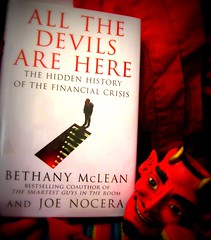Query by oops: can you tell me if i have understood this paragraph on banks and credit and mortgages right ?
PLEASE Study THE PARA Very first
SIVs utilized brief-term industrial paper, sold at low interest prices, to buy longer-term mortgage-backed securities and other instruments with higher prices of return. With the seizure of the credit markets, many SIVs had trouble selling new commercial paper to replace upcoming obligations on older paper. The collapse in sub-prime mortgages and in the commercial paper that supported them has basically adjusted the value of the principal to make up for the outsized returns that these investors got more than the past five years.
The money that banks owe on their commercial paper didn’t modify. These banks are going to supply more industrial paper to purchase mortgage assets in other words, they are going to borrow more quick-term income in order to purchase lengthy-term assets from themselves! That is, if they can borrow the funds in the 1st spot. One particular of the casualties in the rout was the industrial paper marketplace investors are realizing that it backs a lot of lousy mortgage debt, so they are backing away from investing in the industrial paper that backs the mortgages.
NOW – IS MY UNDERSTANDING Appropriate ?
Borrowed cash – The SIVs sold brief-term commercial paper at low prices of interest – so they borrowed cash for a ST at a low IR. They did this routinely to maintain receiving funds.
Lent money – The banks told the folks that we will give you income – mortgage your house at 12 % IR. ( Or the banks purchased mortgage investments from investors.) The banks took the less expensive loans from CP and invested it in longer term mortgage-backed securities and other instruments with greater prices of return.
But when the market collapsed, the value of the home collapsed, borrowers could not pay loans and higher IR, and the bank was left with a property which was not worth 25% of the loan they had provided. Oversized interest prices frequently imply that the investment is in reality sucking money out of principal. Occasionally investors can get away with the gambit for awhile, but sooner or later somebody pays the bill.
Secondly, with the seizure of the credit markets, a lot of SIVs had difficulty selling new commercial paper to replace upcoming obligations on older paper.
Thirdly, The income that banks owe on their commercial paper didn’t modify. Sounds like problems.
Now the banks have paid Rs 100 to the borrower, in return they have a house which is worth Rs 20. How do the banks cover the balance Rs 70 ? These banks are going to offer you far more commercial paper ( and take ST loans at low IR ) to buy mortgage assets in other words, they are going to borrow much more short-term cash at low IR in order to purchase extended-term assets from themselves!
That is, if they can borrow the money in the initial place. A single of the casualties in the rout was the industrial paper market place investors are realizing that it backs a lot of lousy mortgage debt, so they are backing away from investing in the commercial paper that backs the mortgages.
Greatest answer:
Answer by BobWang
An important aspect is the total lack of faith in SIVs, CDOs, and the agencies that purport to price them.
[Quote]
Most of these are mortgage-primarily based securitizations, such as CDOs. The cause for the common gun-shyness is since no-one particular knows what’s in them. This point was produced final Thursday evening on CNBC, where Thomas Patrick presented a strategy to take the performing mortgages out of CDOs and SIVs at par. It was shot down by CNBC reporter Charlie Gasparino on the grounds that performing mortgages might not execute at all in the future. Due to the fact no-one knows what’s in these securitizations, they’re not actually buyable. This impression explains why mortgage-rooted CDOs and SIVs are promoting way under what their present money flow indicates, a disparity that Mr. Patrick’s program depends on.
[/Quote]
Add your own answer in the comments!








